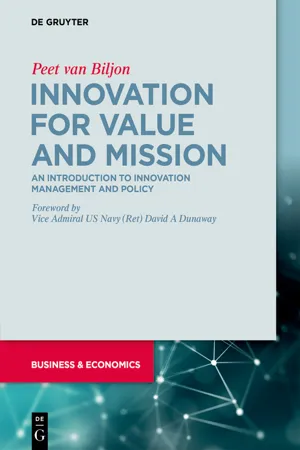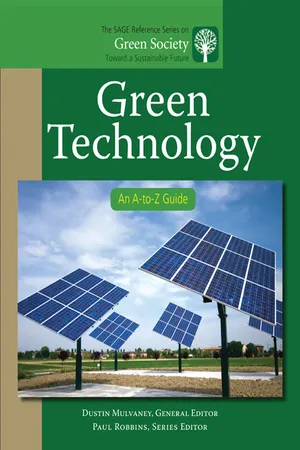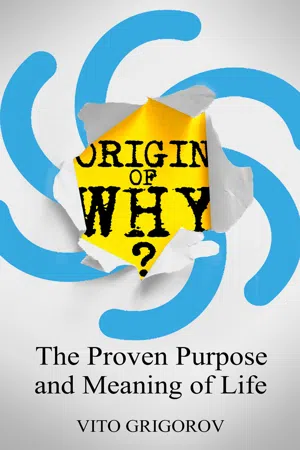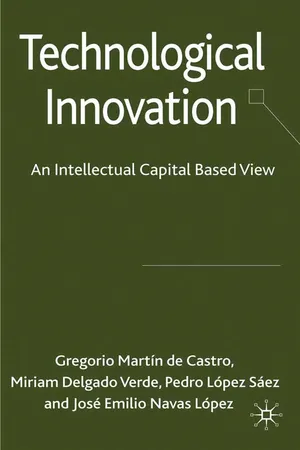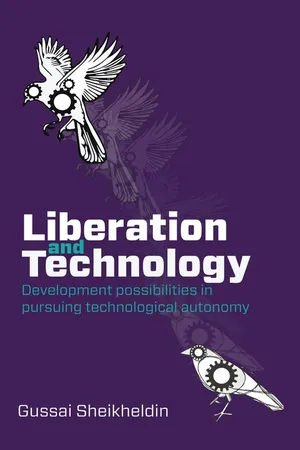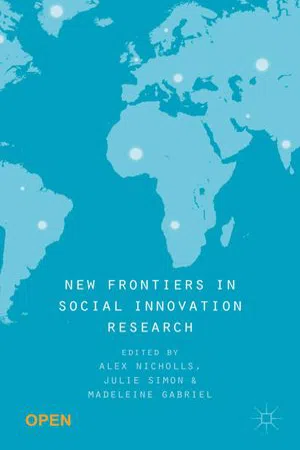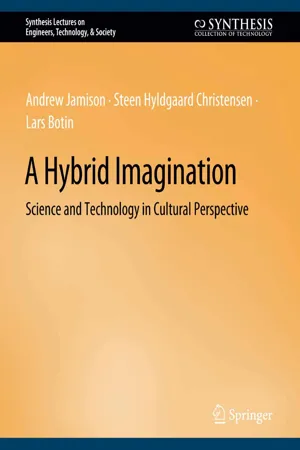History
Technological Innovations
Technological innovations refer to the development and implementation of new or improved technologies that have a significant impact on society, economy, and culture. Throughout history, technological innovations have driven progress and change, shaping the way people live, work, and interact with the world around them. These innovations have included advancements in areas such as transportation, communication, medicine, and manufacturing.
Written by Perlego with AI-assistance
Related key terms
1 of 5
10 Key excerpts on "Technological Innovations"
- Matthew M. Mars, Gary D. Libecap, Sherry Hoskinson, Gary D. Libecap(Authors)
- 2013(Publication Date)
- Emerald Group Publishing Limited(Publisher)
improved particular aspects of the human condition? Such profound technologies would include, but is most certainly not limited to, Gutenberg’s press in the 15th century, the microchip of the 20th century, and future devices that will likely emerge from the 21st century scientific fields such as bio-and nano-technology. Or, should innovation be recognized across a much broader range of contexts that include more modest, so-called low technologies that provide some minor improvements within given locations or markets? One such technological event is the addition of iron blades and moldboards to the plow in the Middle Ages, which contributed to the expansion of European agriculture to the rugged lands located north of the Alps ( Friedel, 2007 ). Does a technology need to be completely novel to be considered an innovation? Or, can a technology that builds upon another technology or set of technologies be described as being innovative? For example, should the innovative features of the optical telegraph of the late 18th and early 19th centuries that proved to be critical to European wartime defense systems be questioned due to the reliance on a telescope design that dated back to Galileo (see Friedel, 2007)? Is innovation synonymous with invention? Or, are there important conceptual distinctions that separate innovation from invention? These and many other similar questions guide the discussion that takes places in the following chapters. The outcome of the discussion is the development of a conceptual framework that is capable of illustrating the implications of human ingenuity on society and revealing just how critical innovation has been and continues to be to the welfare and advancement of mankind. Innovation is most often recognized through achievements that involve the creation or improvement of tangible ‘‘things’’ that involve mechanical, structural, or scientific properties.- eBook - ePub
Why Nations Put to Sea
Technology and the Changing Character of Sea Power in the Twenty-First Century
- Kevin L. Falk(Author)
- 2018(Publication Date)
- Routledge(Publisher)
CHAPTER 2The Impact of Technological Innovation
We live in an unusual world, marked by very great and irreversible changes that occur within the span of a man’s life. We live in a time where our knowledge and understanding of the world of nature grows wider and deeper at an unparalleled rate; and where the problems of applying this knowledge to man’s needs and hopes are new, and only a little illuminated by our past history.—J. ROBERT OPPENHEIMER, UNCOMMON SENSEA nation which invests a great deal of money and uses its best minds in industries directly oriented toward war production will eventually possess arms as good or better than those of a rival whose industry has nonetheless a superior average productivity.—RAYMOND ARON, PEACE AND WARSCIENCE, TECHNOLOGY, AND HUMAN PROGRESSWe live in an era of great scientific and technological discovery. Innovative uses of existing scientific and technological knowledge are merged with new discoveries; many significant scientific and Technological Innovations will be observed during the lifetime of someone born today. It is impossible to fully understand how fundamentally these future advances will impact the everyday lives of people. If the twentieth century is used as a guide for the life-changing innovations that the twenty-first century may bring, then the possibilities seem only limited by human imagination. Men would engage in powered and controlled flight at the beginning of the century; a mere 44 years later the speed of sound would be met and passed in an aircraft—an aircraft as distant from the one used in 1903 at Kitty Hawk as today’s personal computers are distant from the abacus. The power of the atom would be unleashed in wartime, and harnessed for humanitarian purposes in peacetime. Men would walk on the moon and send probes to explore distant galaxies. Few have observed the growth of computer technology over the last twenty years, made obvious to all of us with the success of the PC for home use, without developing a sense of scientific and technical ascendancy in modern society. Looking at all of this change in the span of a single lifetime calls into question whether this degree of change has always occurred so quickly in human history, or whether something new is afoot. Oppenheimer’s quote suggests that engineers and physical scientists have formed a consensus that mankind’s accumulated knowledge is growing at ever faster rates.74 - eBook - PDF
Innovation for Value and Mission
An Introduction to Innovation Management and Policy
- Peet van Biljon(Author)
- 2022(Publication Date)
- De Gruyter(Publisher)
Chapter 2 Technological Progress and Industrial Revolutions The remarkable improvement in living standards enjoyed by most citizens of devel- oped countries over the last couple of centuries was the result of transformative tech- nologies and accompanying innovations in production and consumption systems. An understanding of the nature of technological progress, as well as its implications for the economy and for society, is essential for anyone interested in deriving value from the next generation of innovations. Policymakers interested in harnessing technology and innovation to support their stated missions also need to understand the main propagation mechanisms of technological progress and innovation. The chapter starts with an exploration of the acquisition of knowledge and sci- entific progress and the role of uncertainty in that process. It then introduces sev- eral key concepts related to technological progress and the diffusion of innovation that are essential for industry leaders and government policymakers to understand. Diffusion curves that represent the adoption of innovations in different phases are explained in their sociological and other contexts. Technology S-curves are intro- duced, and their implications for disruptive innovation are explained. The apparent paradox that technological advances over the last few decades have not lifted productivity growth as much as expected is explored and the most likely explanations are discussed, along with their policy implications. The intrigu- ing idea that major technological advances come in decades-long waves known as Kondratieff waves is presented, as well as what insights that offers for past indus- trial revolutions. This is followed by a brief introduction to the Fourth Industrial Revolution, a provocative term recently coined to represent a seeming acceleration of technological advances in areas as diverse as computing, biotechnology, materi- als science. - eBook - PDF
Green Technology
An A-to-Z Guide
- Dustin Mulvaney, Dustin R. Mulvaney(Authors)
- 2011(Publication Date)
- SAGE Publications, Inc(Publisher)
New York: Viking Press, 2005. Shapin, Steven. The Scientific Revolution. Chicago, IL: University of Chicago Press, 1996. Mikael Johansson University of California, Santa Barbara 410 Technology and Social Change T ECHNOLOGY AND S OCIAL C HANGE Every historical epoch has its defining ethos in technology. For the Roman Empire, it was an extensive network of estates powered by slaves; for medieval Europe, feudalism and the church were the most important bulwarks of life on Earth. However, for the modern period, technology and the changes it brings about are the defining feature of the epoch. Technological innovation, though, is not a contemporary phenomenon. Innovation, espe-cially in military and agricultural technology, such as the crossbow that was superior to the longbow or the heavy-wheeled plow that made cultivation of the rich, heavy, and wet soils of northern Europe possible, is a feature of history. However, technological innova-tions in the past were often localized, spread slowly, and took years to manifest in social change. For instance, the plow made its first appearance in the 5th century in Slavic lands and appeared only in the 8th century in the Rhineland. Such technology led to social change over long periods of time. French historians such as Fernand Braudel (1902–1985) have pointed to the existence of long cycles of time over which the social change that technology unleashed become evident. Braudel’s ideas of long cycles of time have inspired many other works—Jacques Le Goff famously looked at how the invention of mechanical clocks changed European conceptions of time, and popular authors such as Jared Diamond have used the idea of long cycles of time to argue that the seeds of European dominance in the 15th century were laid when horses were domesticated and steel was invented. - eBook - ePub
Origin of Why?
The Proven Purpose and Meaning of Life
- Vito Grigorov(Author)
- 0(Publication Date)
- Prosperist Publishers(Publisher)
“This process must continue and we trust at an increasing rate. If we are to bring the broad masses of people in every land to the table of abundance, it can only be by the tireless improvement of all our means of technical production.”14Winston ChurchillGeneticist Theo Dobzhansky once said, “Nothing in biology makes sense except in light of evolution.”15 For us, nothing in human history makes sense except in light of innovation. Before we explore history, we need to lay the rules down for our view of history, which in academic jargon we’ll call innovational historiography.TIME PERIODSHistory shows us the continuing march of innovations breaking through old limits. We call these the “Turning Points” in thanks to Malcolm Gladwell’s book of a similar name The Tipping Point. As Tom Stoppard mentions in Arcadia, “A door like this has cracked open five or six times since we got up on our hind legs.”16 Nobel Laureate in economic sciences, Simon Kuznets said, “The major breakthroughs in the advance of human knowledge, those that constituted dominant sources of sustained growth over long periods and spread to a substantial part of the world, may be termed epochal innovations. And the changing course of economic history can perhaps be subdivided into economic epochs, each identified by the epochal innovation.”17 This is the most productive innovation of a time period, which gives the most actions and combines to make the most innovations. We will make our time periods most relevant by basing them on such innovations. This is not new. Materials have been used, as they were what innovations were built from. It’s why past time periods are named Bronze Age, Iron Age, etc. Archaeologists have long agreed that human history begins with the first tools, so we will continue this by dividing history by the most important innovations that have served humanity best and likely most improved our life expectancy in the process.CONTEXTIt would be great if history was based on immoveable facts, but as it’s written by humans, opinions pop in. The gloom of the Dark Ages may be seen in Europe after the fall of Rome, but at the same time over in Asia the same gloom is not found. Some events of the 1960s are called by many in western nations a “cultural revolution”, but no such revolution happened in the USSR, India or other non-western nations. We also see that each nation has different definitions for what it considers to be ancient, medieval, or modern. As we’re aiming for as close to a standard view of history as we can, we need to look at longer time periods and focus on facts that are as clear as possible. The best facts are innovations themselves, and it’s through their making, spread, and decline that we can define our time periods. When an innovation spreads, it becomes the start of a time period for us, even though that innovation may not have reached most countries of the earth until decades or even centuries later. Time periods end, not when all nations adopt that innovation, but when another more productive innovation starts to spread again in some part of the world. What do we mean by “spread?” - eBook - PDF
Evolution's Edge
The Coming Collapse and Transformation of Our World
- Graeme Taylor(Author)
- 2008(Publication Date)
- New Society Publishers(Publisher)
More and more scientific breakthroughs are the result of systems-based, interdisciplinary work. The new integral worldview represents a profound change from seeing and believing that things exist in isolation to seeing things as Transformative Material Technologies | 3 inseparable from their relationships and contexts. It is the shift from being able to see the trees but not the forest to being able to see both the trees and the forest. Thepromiseofnewtechnologies While humans have always been inventive, the pace of innovation is constantly accelerating as the size and density of populations increase, people become more educated and knowledge becomes more accessible. Tens of thousands of years ago new ideas spread very slowly, as people lived in small, isolated groups and had few ways to record and exchange information. Now the pace of change is so rapid that it is difficult for researchers to keep up with the latest theories and difficult for businesses to keep up with the latest technologies. Innovations tend to come in waves because disruptive innovations open up new technological and commercial possibilities. For example, the practical application of 3 | E OLUTON ’ S E DGE Figure 1: Natural Edge Project electrical theories did not just produce lights, but also electrical motors, batteries, telephones, movies and thousands of other new technologies. Innovative waves are also the result of a critical mass of technologies developing to the point where they can be combined to produce entirely new products. Telecommunication and computer technology had to exist before the Internet could be invented. While we sometimes think of new technologies as the creations of scientific ge-niuses and mad inventors, before new ideas become commercial products they have to be researched, manufactured and marketed. This only happens if gov-ernments and businesses are convinced that commercial opportunities justify the large financial risks involved in developing a new technology. - eBook - PDF
Technological Innovation
An Intellectual Capital Based View
- Gregorio Martín de Castro, Miriam Delgado Verde, Pedro López Sáez, José Emilio Navas López(Authors)
- 2010(Publication Date)
- Palgrave Macmillan(Publisher)
Technological Innovation 53 the value of innovation depends on market success. In a deeper analysis of this issue, Jiménez and Sanz (2006) remarked on the distinction between product innovation – innovation occurring at the moment of its commercialization – and process innovation – innovation occurring at the time of the innovation’s first industrial application. Then, and taking into account previous literature proposals, as well as the intellectual capital framework, we could define innovation as the result by means of which, being fundamentally an intellectual capital-based process, new products and/or processes are created and/or substantially improved. Finally, we would like to point out that our research is focused on technological innovation, which refers to changes made in the proc- esses and products of a firm. The technology definition adopted in this research, based mainly on Navas (1994), Morcillo (1997) and Nieto (2001), uses in its strategic terminology resources, capabilities, know- ledge, methods and so on that embody the concept of technology (see Table 4.1). On the other hand, it is important to distinguish between generation and diffusion processes of new technologies – the innovation processes, and knowledge stocks a firm can possess – its technological endowment. So, because the process of change refers to technology levels, innova- tion is usually called technological innovation. Furthermore, and as several authors propose, administrative innovation is also considered (see the next section). Nevertheless, in the proposal made by OECD (2006), the term ‘technological’ has been deleted from the conceptu- alization of innovation because it is possibly a wrong interpretation as ‘materials and high technology equipment handling’. Finally, Zheng (2008) remarked on the importance of knowledge creation in innovation, because any new process, product or service derives from new ideas. - eBook - PDF
Liberation and Technology
Development possibilities in pursuing technological autonomy
- H. Sheikheldin(Author)
- 2018(Publication Date)
- Mkuki Na Nyota Publishers(Publisher)
Incoherent definitions could obscure the issue, rather than illuminate it, or lead to incoherent conclusions. Coherent definitions of technology, on the other hand, can be multiple, as we shall see, but each has to be consistent as well as suitable for the context in which it is used. Encyclopaedia Britannica defines technology as “the application of scientific knowledge to the practical aims of human life or, as it is sometimes phrased, to the change and manipulation of the human environment.” The Greek origins of the word are the two words techne and logos , with the first meaning ‘art, skill, craft’ and the second meaning ‘expression of ’—rendering a somewhat literal meaning of ‘expression of skill, art, and craft’. Writings that focus on technology and development, and technological change, have provided various and keener definitions of technology. Attempts at definition that tend to be so broad as to include every aspect of the subject matter run the risk of being too broad to be called definitions.2 If research on topics of technological change depends on such broad definitions of technology, it will likely have trouble avoiding vagueness. “To define, after all, is to set limits.”3 Everett Rogers (2003, 13) proposes a conceptual definition: “A technology is a design for instrumental action that reduces the uncertainty in the cause-effect relationships involved in achieving a desired outcome.” According to Rogers a technology would typically have two components: (1) a hardware aspect, represented by the material or physical embodiment of a tool; and (2) a software aspect, represented by the information base for the tool. - eBook - PDF
- Julie Simon, Madeleine Gabriel, Alex Nicholls(Authors)
- 2015(Publication Date)
- Springer Open(Publisher)
This is especially important from The History of Social Innovation 55 an analytical standpoint, as including a range of historical examples considerably increases the pool of social innovations that can be stud-ied, allowing researchers to test multiple theories and look for overarch-ing patterns and commonalities across cases. The theoretical framework employed here to explore historical social innovation is composed of three broad elements: the driving force of new (and new combinations of) ideas into the adjacent possible, the compilation of different agents’ activities within a specific case and the importance of understanding the obstacles and opportunities at the niche and landscape level. New ideas; novel combinations Combination of two or more existing ideas, theories or products is commonly acknowledged as a key driver of technological innovation and scientific discovery, and similarly is seen as a key mechanism of innovation generally (van den End and Kemp, 1999; Becker et al. , 2006; Arthur, 2009; Biggs et al. , 2010; Thagard, 2012). Arthur (2009) suggested new technologies and technological domains emerge as the result of the discovery of new naturalistic phenomena, as well as through the com-bination of existing technologies within and across domains. Similarly, looking at 100 scientific discoveries and 100 Technological Innovations, Thagard (2012) sought common features of how individuals involved in those breakthroughs had perceived and/or created novelty. Thagard credited combinations of mental representations (ideas that combine two or more distinct concepts, products, etc.) as the most common, compelling explanation for the creative process. This research considers a social dimension of the combination hypothesis of invention. - eBook - PDF
A Hybrid Imagination
Technology in Historical Perspective
- Andrew Jamison, Steen Hyldgaard Christensen, Lars Botin(Authors)
- 2022(Publication Date)
- Springer(Publisher)
Indeed, it can be suggested that the dominance of the commercial, or economic meaning has led to a relative neglect of what might be termed the social and cultural meanings of science and technology. Many forms of scientific and technological development are intrinsically social, in the sense that they are attempts to apply technical skills and scientific ingenuity to the solving of social problems and/or the resolution of social conflicts. The aim has been to provide a kind of structural, or what is often referred to as “infrastructural,” contribution to a unit of social organization, be it a 2.2. THE STORY-LINES OF SCIENCE AND TECHNOLOGY 15 What do science and technology mean? | making money, doing business: ideas/inventions > innovations > products > profits | solving problems, controlling society: interests > actors/networks > artifacts > systems | empowering people, using things: movements > institutions > values/behavior city or a nation-state or a society. It has usually involved one of another form of system-building or systemic thinking, by which various component parts – both scientific, technical and non-technical, both non-human and human – are brought together into a larger coordinated effort. The interesting questions in relation to contextual knowledge in this kind of science and technology revolve around the social sector or domain in which these processes take place and the particular kinds of competence or expertise that are required. In these areas of science and technology, the task has generally been to transform an idea, plan, design, or vision into material manifestations and, by so doing, help to “fix” a problem or resolve a conflict that has been identified as socially significant – public health, energy supply, electricity distribution, environmental protection, transportation planning, etc. This can be thought of as the social, or professional meaning of science and technology.
Index pages curate the most relevant extracts from our library of academic textbooks. They’ve been created using an in-house natural language model (NLM), each adding context and meaning to key research topics.


